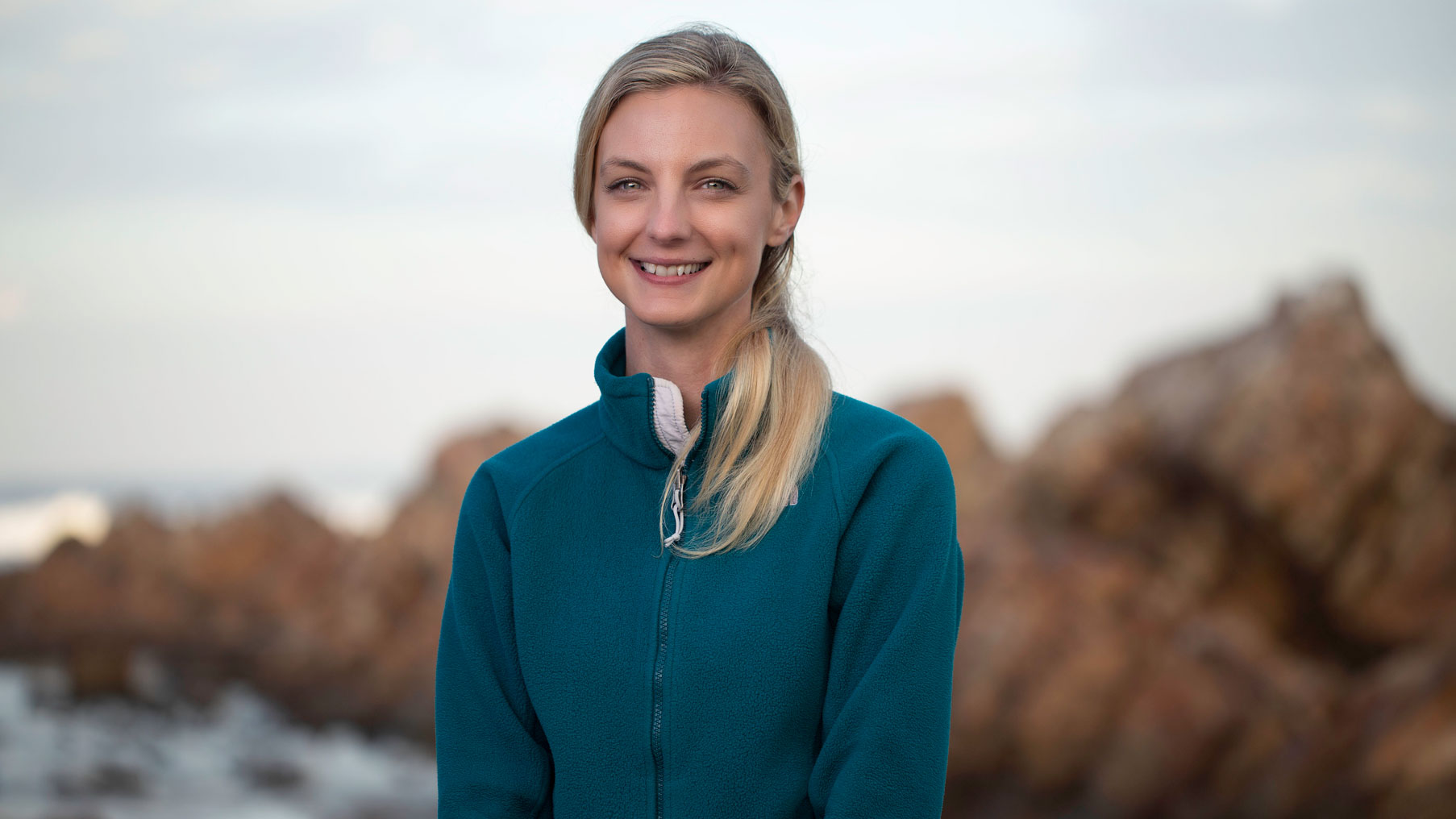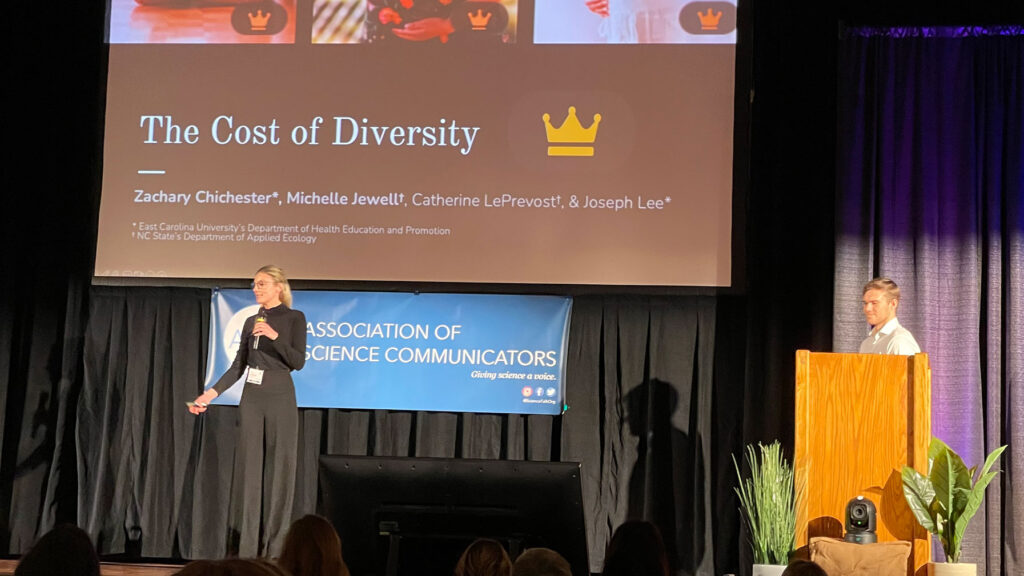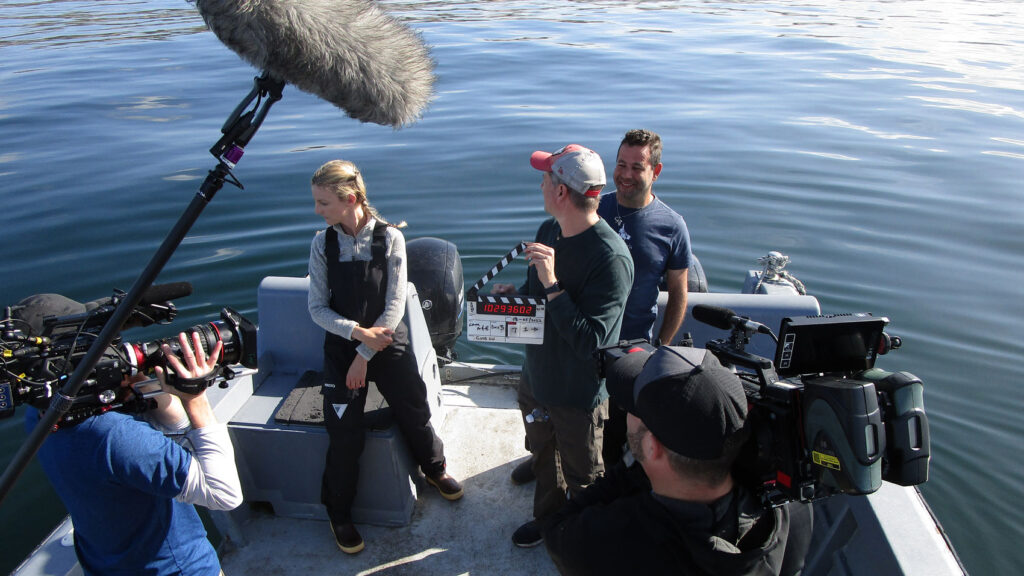Science Communicator Makes a Splash

Although the laws of physics say otherwise, it seems as if science communicator Michelle Jewell with the Department of Applied Ecology is everywhere right now.
She’s been teaching a class with a colleague, leading a statewide group for science communicators, making national presentations and, occasionally, diving from a crane while filming a Discovery Channel episode for Shark Week.
We sat down with Michelle to talk about her wide-ranging work as a science communicator at NC State and as a leader and advocate.
You presented research that you co-authored about the lack of diversity in stock photos at the Association of Science Communicators national meeting recently. What inspired the research?
Catherine LePrevost, an associate professor and agromedicine Extension specialist in our department, came to me with a fish consumption advisory poster that they were putting together. Part of the stakeholder feedback included wanting to have a picture of a real human being on the poster rather than clip-art-esque silhouettes. The community members at risk were pregnant women or young children, so we decided that we would find a photo that represented that group.
When we went online to try and find stock images of a pregnant person with children, again and again, most of the images that came up were of a blonde, white woman laughing with a salad-type photo. This stylized type of stock imagery did not at all reflect the population that we were trying to reach, which was mostly people of color, especially the Hispanic populations that were most impacted by this advisory.
This problem with stock images is something that we communicators run into all the time. And I started to wonder, has anybody anywhere quantified this and put it into the literature? And the answer was kind of yes and no. Articles had talked about it as an issue, but we couldn’t find a paper that had run the numbers and said, “This is the measurable problem that we’re dealing with when it comes to diversity in the top searches of stock images.” So that kicked off this whole project.

How did you carry out the research?
Catherine and her colleagues at East Carolina University, in particular, were interested in health topics – image searches that directly related to things like vaccination or stopping drinking or healthy eating. You won’t be surprised that we ran into the same issues with a really huge lack of diversity with those search queries as well for the images.
We were able to put the study together with the help of Zach Chichester, the undergraduate who looked at the photos and coded them, and finally put that in the literature. Because once we have a good measure of that problem, now we can address it, right?
We hope that the paper will become a citable publication for folks creating budgets so that people can say, “Hey, we need additional funding for our own photographers or our own illustrators because we can’t rely on these stock image websites to necessarily give us images that not only represent the communities that we want to work with, but also the nuance around some of these topics. We’re just not going to find it there.”
Read more about the research in the open access journal article.
Right now you’re leading the Science Communicators of North Carolina. How did you become involved with the group, and how are things going?
When I first moved to North Carolina, like most people looking for community, I was trying to find folks who were doing similar work. I found the Science Communicators of North Carolina (SCONC) and went to events, signed up for different online get togethers, progressed to becoming a board member, and then shortly after that, was promoted to president.
I’ve really enjoyed being a part of that group at all levels. We’re now tackling a long to-do list of things that the organization has wanted to do for quite some time. I’ve been able to lean on my background in nonprofit organizations to jump in and start working on some of the nonprofit-related organizational missions. SCONC now officially this year is a federally recognized nonprofit. That changes our landscape a lot when it comes to how we can secure funding, the different types of programs that we can run and the amounts of grants that we can give to members or other science communicators for their various projects. I’m currently working with the Burroughs Wellcome Fund to organize a large-scale brainstorming session on what the future of SCONC looks like and how we can best support science communicators here in the Triangle and, maybe, further afield in the Southeast.
The Triangle is a really rare spot, and I think people are just beginning to recognize how fertile the ground is here when it comes to science communication. NC State is one of the few universities that have full-time science communication positions and a science communication minor for undergraduates. I think it’s wonderful that NC State is one of the leaders in prioritizing and investing in science communication.
How did you become a science communicator?
I was a science communicator before the term really started to circulate. During my master’s, I was working at a nonprofit, and that was really what sent me into communications. At that time, the nonprofit was growing and needed somebody who could essentially be the point-of-contact for the organization, like giving talks and being the person that the media called, to being a representative that helped speak with stakeholders about different policy measures we wanted to put in place. I was doing research at the time as well, and I found that communications for me just fit better.
And I just stuck with it. I worked in similar roles from nonprofit to nonprofit and worked freelance for a while in there, too, helping other nonprofits and institutions with their communication strategies. And then eventually, this position at NC State came up, and I thought it seemed like the perfect fit at the time, and it has been ever since.
What are your favorite parts of the job?
I love working with students. Part of what really drew me to a university setting was the ability to be more involved with students in their journeys in science communication. And I get to work with incredible students.
Myself and Catherine LePrevost, who’s the co-author of that study as well, co-lecture a class every spring semester called Applied Science Communication. I’m very proud that many of those students are working in science communication roles either at museums or they’re freelance or at institutions. Some have gone on to graduate studies in science communication as well. And even the students who stayed outside of communications have emailed us to talk about how useful our class has been for their speaking and interviewing skills. I feel that speaks to the applied nature of the course that we’ve been running, and I’m incredibly proud of the students’ work, inside and outside of the classroom.
For example, a student in our class, who also happened to be an EMT, created a wonderful product that was a wallet-sized first aid pamphlet in Spanish, specifically for health issues commonly experienced by farmworkers. They used many scicomm skills like active listening, effective design and concise writing tailored to a specific audience. It’s been really wonderful to watch students flourish in something that they’re passionate about while also answering a need, linked to extension, for a lot of the faculty members that the students work with here in the department.
Why is science communication important?
So much of science has a huge impact. Not only direct impacts on, say your drinking water or the food you’re eating, but an impact on our greater understanding of how the world works and how we understand that world.
The scientific process itself is really important for folks to understand and feel a connection with. Science communicators are that bridge to not only what’s happening in research but how it is happening. Strengthening those personal connections to research is massively important, especially since we are living in times of incredible change.
We have seen during the pandemic how important good communication is during times of crisis and how detrimental bad communication is during that period, too. We need to invest in science communication now so that the future has great science communicators ready to help communities navigate and adapt to the changes coming our way.

You recently took time away for a shark research expedition in New Zealand as part of work you’ve done since before joining NC State. How did that go and when can we see the results?
This was a project with the Discovery Channel for Shark Week. And for me, it was incredibly exciting because I was able to take ideas that are pretty well known in South Africa about white shark populations and test those out in New Zealand waters, which is a new-ish population of white sharks. They have a really different aggregation style in New Zealand, meaning that their meeting points and their behaviors look really different than the meeting spots in South Africa do.
It was incredibly challenging, everything from the boats to the water to how we got in and out of the water, which was via a crane, so you felt like the Terminator being lowered slowly into the water. Not to mention there are white sharks in the water, too. So there were all sorts of elements of it that were high stakes and stressful, but we found some really cool stuff that I’m not allowed to talk about until after the show airs. It’s definitely one of the shark-iest places I’ve ever been in my entire life, and hopefully, a place that I’ll get to go back to next year and try out some new tech to understand this population better. But as long as everything goes to plan, this show should be on Shark Week this summer.
What’s next with Discovery Channel?
Shark Week is a really important week for people who are interested in sharks and the oceans. We call it the Super Bowl for marine biologists because something like 20 million people watch it every year. So it’s a huge platform to talk about marine science and also feature who marine scientists actually are.
For many years, hosts on Shark Week were exclusively men. A recent survey showed that roughly 60% of shark researchers are women, but you wouldn’t know that if all you knew about shark research came from watching Shark Week. They still have a lot of room for improvement there, but it’s been great to be part of that change that’s been needed for a long time. As far as I know, I’m the first woman shark researcher to be the main host and hold the week’s prime time slot, and I’m incredibly proud to work with the production team that makes all of that happen. All of the blood, sweat and tears are worth it when I read emails from viewers who say that they watched one of our shows with their daughters and how impactful seeing someone like me on TV was for them.
I work a job that I love, and I am part of an organization at NC State that I’m super passionate about, and I get to have these incredible opportunities with really large platforms to flex my science communication skills and talk about things that I love, too, like sharks and the oceans.
- Categories:

